
views
Selecting and Storing the Fish

Get the fish from a trustworthy source. Talk to a local fishmonger who you trust about the best fish to use for sushi. It's important to let the fishmonger know that you'll be eating it raw. Ask for a fish that has been previously frozen, since the freezing process will have killed any parasites in the fish.The fishmonger may sell you previously frozen fish or frozen fish that you'll need to thaw at home right before using.

Pay attention to the condition of the seafood counter. If you're unsure if you're getting fish from a reputable source, as if they fillet their own fish or if they purchase them pre-filleted. Try to buy from a fishmonger that fillets their own fish since this reduces the chance of improper handling. You should also watch how the fishmonger handles the fish. They should change gloves frequently and disinfect their knives and cutting boards. If the fishmonger advertises sushi-grade fish, ensure that it's not stored with non-sushi grade fish. The fishmonger should also change gloves before handling the sushi-grade fish.
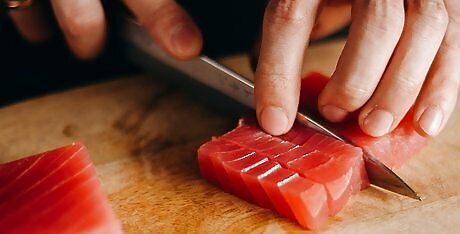
Choose the fish. Ask the fishmonger to show you several fish to choose from. You shouldn't be able to smell a fishy smell from any of the fish or this could signal that the fish is no longer fresh. If the fish still has eyes, they should look clear and bright, not dull and cloudy.The fishmonger may hold up the fish for your inspection. If the fish stays straight like a ruler, it is extremely fresh. If it flops, the fish is older.
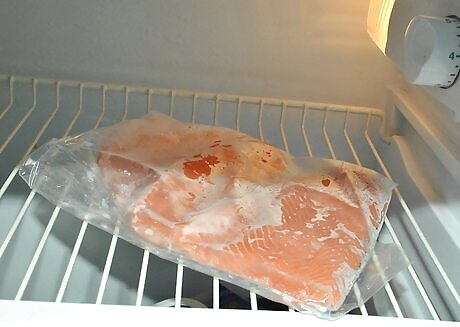
Store the fish. Once you've bought your fish, try to use it as soon as you can. The longer you store it in the refrigerator before using it, the more bacteria it may grow. Place the fish in the refrigerator and use it within 24 hours. You could also freeze the fish and thaw it in the refrigerator before making sushi. To safely thaw the fish, remove it from the freezer and place it in the refrigerator. Ensure that there's plenty of space around the fish so the cool air can circulate. Only freeze the fish if it hasn't been frozen before. Ask the fishmonger about this before you buy the fish since many seafood counters freeze their fish before selling them.
Cutting Fish for Sushi
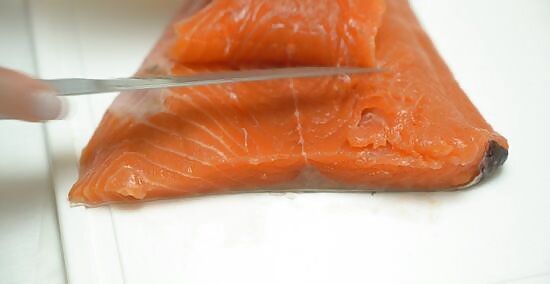
Cut off the triangle tip. Take a sharp sushi knife and carefully cut the triangular tip off of your fish. If you're using Yellowfin tuna, you should have a triangular piece that measures about 1-inch by 3-inches.The triangular piece is tender and free of tendons, so it shouldn't be difficult to slice this piece off the end.
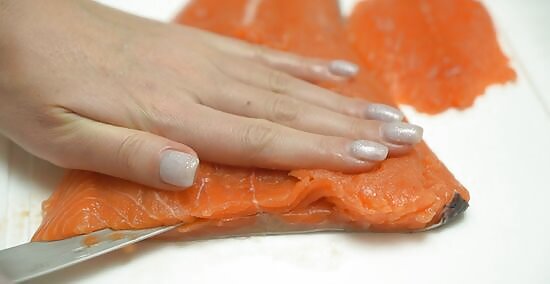
Slice a layer off fish. Measure about 1 inch below where you sliced the triangle tip off of the fish. Carefully use your sushi knife to cut a horizontal layer of the fish evenly across the piece. You should end up with a layer of fish that's about 1-inch by 4 or 5-inches long (depending on the size of your fish). You can use this piece for making sashimi or nigiri since it doesn't contain tendons which could make the bites chewy.

Remove the tendon from the fish. You should be able to see a white tendon. The tendon looks like a line running diagonally from the top of your tuna down towards the skin. To remove it, slice the piece of fish in half lengthwise, cutting down near the skin. Avoid cutting into the skin since it also contains tendons. Instead, pull the fish to one side and use your knife to separate it from the tendon near the bottom. You should also remove the other half of the fish piece from the skin by holding your knife parallel to the skin. Slide the knife between the skin/tendon and the meat of the fish.
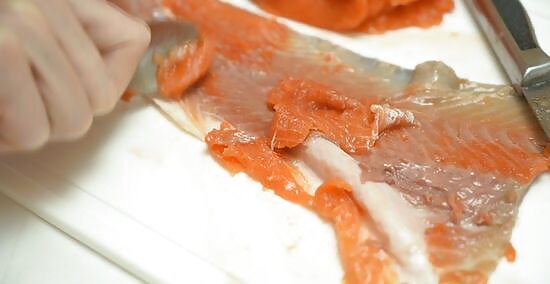
Scrape the fish off of the skin. Place the skin on a cutting board so that the side that still has some fish meat is facing up. Take a teaspoon and scrape it against the skin so the bits of fish are removed. You'll end up with small bits of tender fish that are good to use in sushi rolls.If any large clumps of fish come off, ensure that there aren't any small bits of tendon by scraping the clumps with your teaspoon.
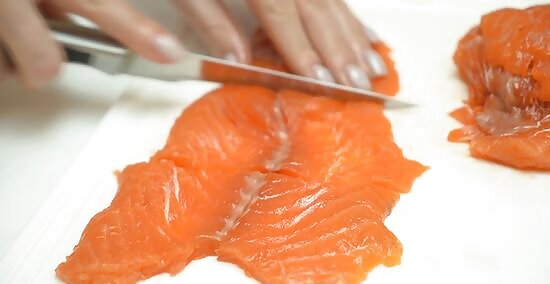
Cut the fish for sashimi. Take the triangular first piece of fish that you cut. Set it on your cutting board so the tip of it is pointing up. Use a sharp sushi or sashimi knife to cut it in half. You'll want to cut down directly through the triangular tip so you end up with two even pieces. Slice each of these pieces into three more pieces. This will make a total of 6 sashimi. If your piece of fish is large, you may want to cut the sashimi into 9 pieces. The pieces will be thin chunks of fish that you can serve immediately. Clean cuts are very important. When you are cutting the fish, use one long stroke instead of going back and forth.
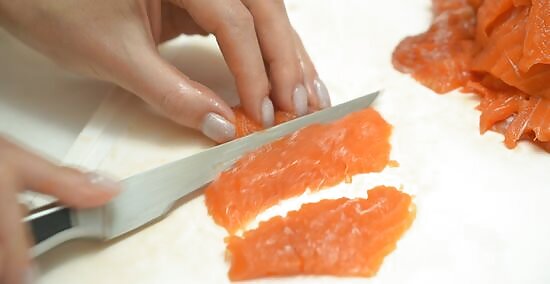
Cut the fish for nigiri. Find the second piece of fish you cut which should be a layer about 1-inch by 4-inches. If the piece doesn't already have a slant at the end, take your knife and carefully slice the end of the piece so it's at a 45-degree angle. Place your knife 1/4-inch away from the end of the piece and slice down at the angle. Continue to do this until you've sliced the entire piece. Each slice of nigiri should be about 1 to 1.5 ounces in weight. They should be thin and uniform.

Cut the fish for sushi rolls. Use the two pieces of fish that were closest to the skin and cut them into small chunks or cubes. These pieces work best if you'll be using them to make sushi (rolled along with rice). Cut the fish into small even pieces that will be easy to eat.You may want to cut the bites of fish very small if you'll be making a sushi roll that has several ingredients. This will make it easier to roll and to eat.


















Comments
0 comment